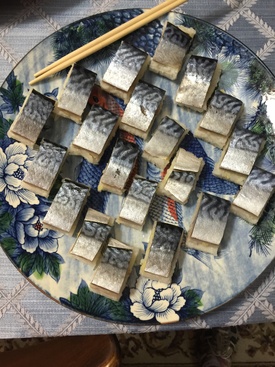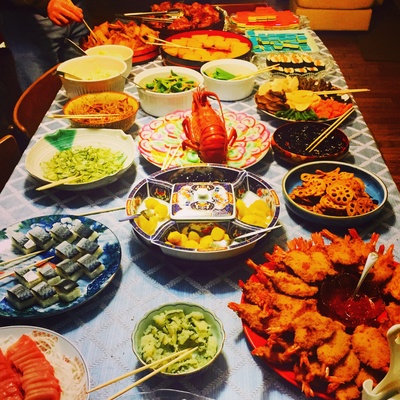Japanese New Years was one of the few traditions that made the jump when my great grandparents, like many others, left Japan for a better future on American soil. My grandmother, the designated New Year’s host for as long as I can remember, always began her preparations several days in advance, so every year my parents, my brother, and I would drive from our Orange County home up to my grandmother’s Los Angeles residence to help her prepare.
For as long as I can remember, New Years was exciting not just because of the delicious food I’d get to eat, but because it was one of the only times I truly felt Japanese. As a fourth generation Japanese American who grew up in a predominantly non-Asian community, I rarely had the opportunity to eat Japanese food, much less experience the culture. However, New Years was one of the few times my family and I could grow closer to our heritage, if only for a moment.
My grandmother’s preparations always began with a trip to our local Japanese market, as she made it a point to cook as many of the traditional foods as possible, rather than settling for a pre-made sushi or bento set. Walking up and down the aisles, I became acquainted with a host of Japanese ingredients that I would rarely if ever see otherwise. Bags of dried shiitake mushrooms, furry sato imo potatoes, and long stalks of gobo went into the cart, along with fish roe, kamaboko, and pale, oblong lotus roots, to name a few.
Step two was always the sashimi. Though not technically a traditional New Years ingredient, sashimi had somehow made its way into the workings of my grandmother’s New Years, and was now an indispensable part of the feast to come. I distinctly remember early mornings in her car, still half asleep, heading downtown to Pacific Fresh Fish on 6th street to pick up cuts of tuna, hamachi (yellowtail), and tako (octopus) for sashimi. Once back home, the fish went into the fridge while the rest of the preparations got underway.
In true Asian fashion, we cleaned the house from top to bottom, swiffering the floor until it shone, replacing all the bathroom towels, and washing down a year’s collection of dust and dirt from the front and back patios. Meanwhile, in the kitchen my grandmother would have several pots boiling while she chopped, skinned, and diced on an assembly line of cutting boards set up along the countertop. Growing up, I probably got in the way more times than I was useful, but as I grew older, my grandmother began delegating tasks to me one by one, slowly pulling me further and further into the measured chaos that was the kitchen the day before New Years.
There was one dish in particular that always stood out - my grandmother’s saba (mackerel) zushi. A family recipe passed down from her mother, it was a star attraction of the New Years feast. It was one of the first dishes I learned to make, but also one of the most time intensive and difficult to get right. Hunched over the saba fillets, I’d pick out bones with a tweezer until I was sure my fingers would fall off. Peeling off the skin was a whole other challenge, as the trick was to get it off without removing the saba’s distinctive silver and blue coloring. I almost always got it wrong, and the ones I prepared could always be distinguished by the awkward nicks and gashes along the saba’s silver and blue shine.
New Years day we’d always start with ozoni soup and grilled mochi, with the Rose Parade playing on the living room tv. There was little time to rest though, as there was still cooking to be done. Contrary to traditional notions of osechi ryori (Japanese New Years food), which state that such dishes should be prepared prior to New Years day, we always did at least half our cooking the day of. There would be two fryers going outside for shrimp tempura, while in the kitchen, my grandmother would have trays of rice cooling for the saba and inari zushi still waiting to be made. My mother would be at the counter slicing sashimi, and there would usually be another dish cooking on the stove, perhaps the kinpira or kombu tsukudani, that we’d somehow forgotten the day before. An annual adrenaline kick, we never had everything ready until the first relatives were walking through the door. Hectic as it was though, the rush was always worth it.
Bolder and more gregarious than any osechi ryori set, my grandmother’s New Years was truly a sight to behold. Down the length of her extended dining room table, the traditional dishes we had spent the last few days making were plated on fancy Japanese platters and joined by a multitude of other dishes brought by relatives. Wontons, potato salad, and seven layer jello mingled alongside kazunoko, kuri kinton, and renkon sunomono in a tantalizingly delicious display. In many ways, it was an accurate reflection of our Japanese American identity, supplementing traditional Japanese elements with Americanized flavor and personality.
Fast forward to the present, and New Years is once again only a few months away. However, with the passing of time comes inevitable change. My grandmother is no longer here, having departed this world just a few years ago, but still many years too soon. Gone too is the home that decades of New Years celebrations were held in. My mother has since assumed the tradition, but each year, the question of whether there will be another New Years floats uneasily in the background, as though without my grandmother, it had lost the anchor that gave it purpose. Though my mother has not yet missed a year, there is a stark contrast between her view of New Years as an expense of time, effort, and money, and my grandmother, who saw it as something necessary and integral; something that was simply part of what it meant to be Japanese American.
New Years is when we feel my grandmother’s absence most strongly, and each year that she is gone, I wish for nothing more than to hear the sound of her voice, loud and inviting, calling me to join her in the kitchen again. However, in her absence, I have also realized what New Years meant to her. It was not just about new starts, or wishing for good luck, though that is the purpose of many of the foods we cook. To my grandmother, Japanese New Years was more than a tradition; it was a way to bring our family together, to bridge the distance and obligations that pulled us apart, and if nothing else, to use the humble warmth of food and family to preserve our cultural identity in an increasingly busy world.
© 2018 Cody Uyeda







